Why Design Psychology Matters
Insights from 12 Mid-Century Modern Masters of Design
The field of design psychology examines how the built environment shapes human behavior, emotions and well-being. From the layout of city streets to the furnishings in our homes, the designed world is a powerful yet often invisible influence on our inner lives.
Nowhere is this more important than in spaces dedicated to mental health and personal growth, such as therapy offices. The design of the therapeutic environment becomes the client’s initial impression of the quality, style of and inform the relationship dynamics of the therapy journey.
As philosopher Robert Pogue Harrison writes, chairs are “the most ubiquitous and important design element in any interior space.” More than mere furnishings, they are “a kind of exoskeleton, a second body, that mediates between our soft anatomy and the hard surfaces of the designed world.” The chair we sit in shapes our posture, our alertness, our sense of safety and repose.
When designing a therapy office, chair selection is an opportunity to create an environment conducive to openness, introspection and growth. Design of the therapy space is a way to stimulate a clients creativity and emotional interest in the therapeutic process before a word has been said between patient and therapist. An eclectic mix of iconic midcentury designs can imbue the space with a sense of timeless comfort, understated beauty, and humane values.
The Eameses: Intuitive Futurism
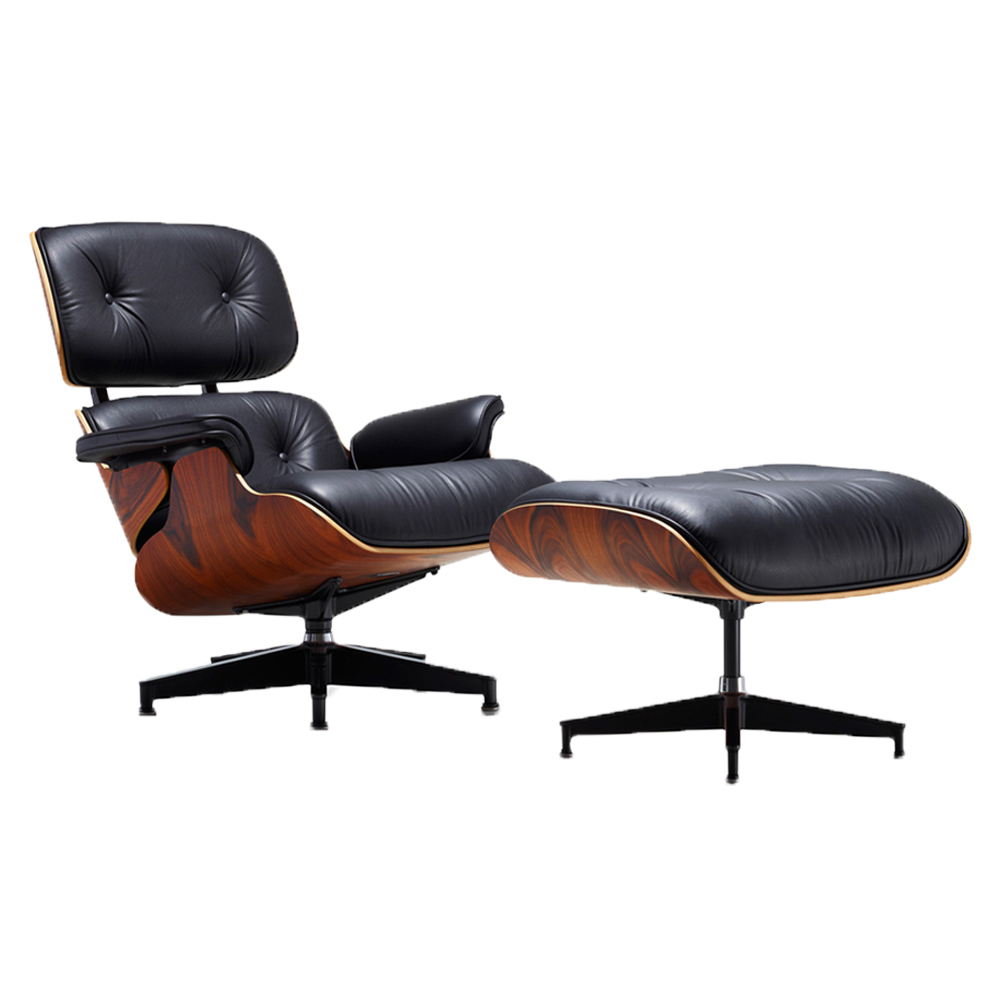
Herman Miller Eames Lounge
No midcentury designers had a greater impact on the look and feel of postwar America than husband-wife duo Charles and Ray Eames. Their prolific output spanned architecture, furniture, textiles, film, toys and exhibitions, giving them an unparalleled platform to shape the period’s visual culture.
Central to the Eameses’ design philosophy was a faith in the power of human ingenuity and technology to shape a better world. They saw their work not as rarefied art, but as a vehicle for social good, a tool for democratizing access to beauty and comfort. As Charles put it, “the role of the designer is that of a very good, thoughtful host anticipating the needs of his guests.”
Designed to feel like “sitting on a well worn catchers mit”, this humanistic ethos found expression in the couple’s iconic lounge chair and ottoman (1956). With its molded plywood shell, supple leather upholstery and sleek aluminum base, the design reinvented the overstuffed recliner for a modern audience. Its reclining angle and enveloping headrest provide what the Eameses called “a special refuge from the strains of modern living.”
For Ray, the key to timeless design was an almost mystical attunement to the beauty of everyday things. She had an uncanny eye for the poetry of the commonplace, the soul in manufactured objects. “What works is better than what looks good,” she said. “The ‘looks good’ can change, but what works, works.”
It was this intuitive sense of rightness, this ability to distill the zeitgeist into physical form, that made the Eameses such visionary designers. Their work bridged the gap between avant-garde aesthetics and mainstream taste, high technology and homey comfort, artistic integrity and industrial production.
In a therapy office, an Eames lounge chair or rocker embodies the couple’s optimistic faith in human potential. It signals creativity, open-mindedness, and a space where clients can dream expansively about the future while feeling supported in the present.
There is an Eames chair in James Waites office at Taproot.
Egg Chair: For there therapist with cracking insight

Arne Jacobsen’s Egg Chair (1958) is a midcentury icon that has come to symbolize the space-age optimism of its era. Originally designed for the SAS Royal Hotel in Copenhagen, its curvaceous form was inspired by Eero Saarinen’s Womb Chair and the organic shapes of contemporary sculpture.
Fusing the lines of the Victorian wingback chair with the organic curves of nature the Egg chair seems to hover and swivels like a planetary sphere. While the wing back chair originated in 17th century England as a way to trap and reflect the light and heat of fireplaces in therapy it can both trap and reflect but also amplify the voice of the patient and the therapist.
The Egg’s padded fiberglass shell and semi-reclined posture create a sensation of being gently cupped and supported, while the swivel base allows for easy movement and 360-degree views. The four-star aluminum base enhances the overall feeling of futuristic lightness.
In a therapy setting, the Egg chair provides a reassuring sense of enclosure without feeling confining. Its high back and winged sides create privacy and focus, while the swivel mechanism puts the seated in control of their orientation like a retro futuristic captains chair. The padded upholstery and contoured shell hold the body almost tenderly, fostering a sense of safety and care.
Joel Blackstock and Alice Hawley have the Jacobsen Egg chair in their offices at Taproot
Wegner’s Wishbone and Ox Chairs: Organic Minimalism
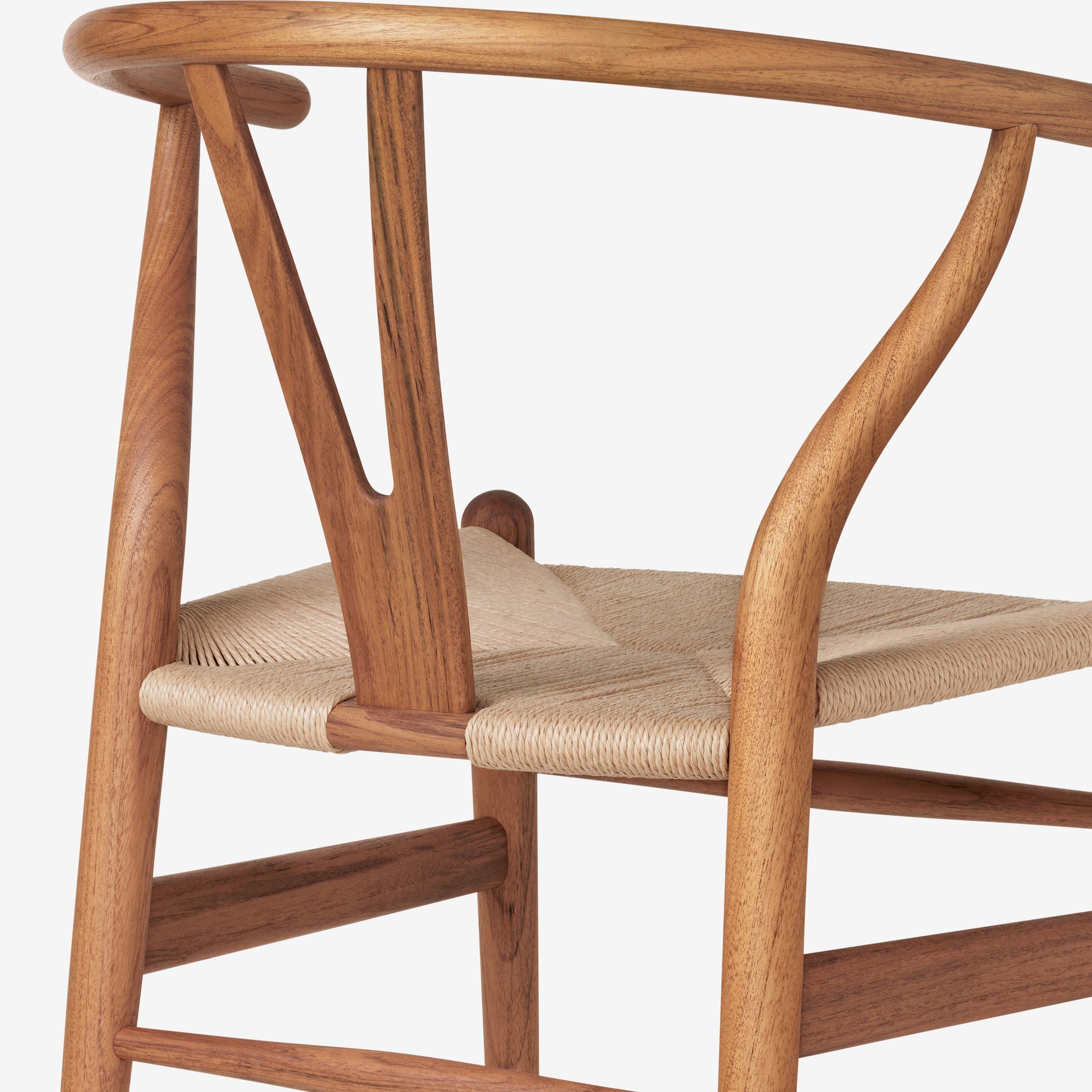
Wishbone Chair

Ox Chair
Danish designer Hans Wegner was a master of distilling chairs to their essential elements. With over 500 seats to his name, he earned the moniker “The King of Chairs” for his prolific yet unwaveringly high-quality output. Two of his most iconic designs, the Wishbone Chair (1949) and Ox Chair (1960), demonstrate his philosophy of organic minimalism.
The Wishbone’s steam-bent solid wood frame and woven paper cord seat pay homage to the traditional Chinese Ming chairs, yet its pared-down geometry and tensile strength are distinctly modern. The backrest is a marvel of ergonomic engineering, its gentle curve cradling the spine like a protective hand.
The Ox lounge chair takes its name from the twin “horns” of its exaggerated winged headrest. Low-slung and luxuriously padded, it updates the classic Chesterfield for a more informal age. The sloped armrests invite an easy sprawl, while the swivel base accommodates animated conversation.
Wegner’s deep respect for wood as a living material suffuses both designs. The visible joinery and gently splayed legs celebrate the natural strength and warm tactility of oak, walnut and cherry. There’s an organic rightness to his forms, a sense that they’ve been gently guided into existence rather than imposed on the material.
In a therapy office, Wegner’s chairs offer a calming refuge, their harmonious proportions and natural finishes inviting presence and inward focus. The meticulous craftsmanship signals a space of considered intention, while the sensuous curves hold the body securely without feeling confining.
We have some wishbone chairs in the Peak Neuroscience offices at Taproot.
The Wegner Hoop (Peacock) Chair: Sculptural Poetry

Wegner Hoop Elm and White Boucle
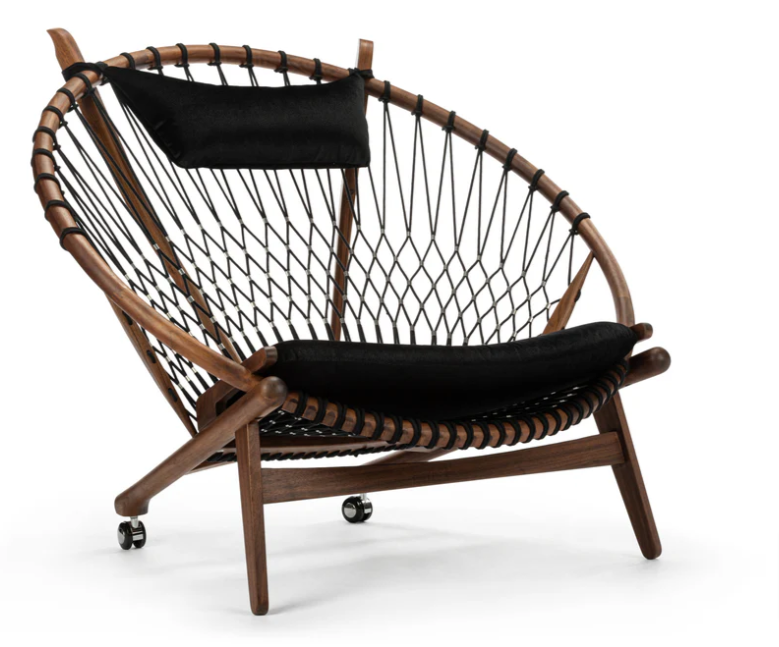
Wegner Hoop Chair Oak and Aniline Leather
Another of Wegner’s masterpieces, the Peacock Chair (1947), is a virtuosic study in bentwood construction. Inspired by the spindle-backs of traditional Windsor chairs, its fan-like backrest curves up and around the sitter like the tail of its namesake bird.
The chair’s 14 steam-bent spindles, each secured with only a few visible screws, create a lace-like pattern that’s both visually ethereal and physically robust. The woven cane seat appears to float above the gracefully tapered legs, enhancing the overall sense of lightness.
Despite its delicate appearance, the Peacock is a marvel of structural engineering, its components working in perfect concert to support weight and movement. Wegner’s genius lay in his ability to create chairs that look effortless and sculptural, yet are built to withstand generations of use.
In a therapy room, the Peacock chair makes an artful yet approachable statement. Its woven seat is breathable and forgiving, while the winged back provides a sense of enveloping security. The lyrical bent-wood form delights the eye and invites contemplation, like a piece of functional sculpture.
We have this chair in our podcast studio at Taproot.
Bruunmunch Lobster Chair: Contemporary Comfort
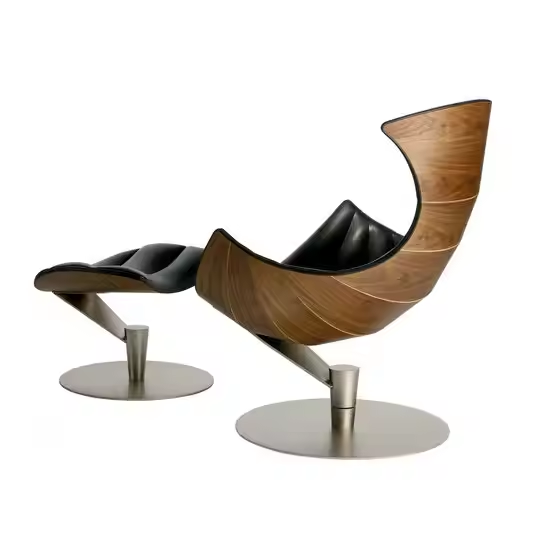
The Bruunmunch Lobster Chair, designed by Danish duo Lund and Paarmann in 2008, is a contemporary take on the classic lounge chair. Crafted with FSC-certified walnut veneer and supple Paris Passion leather from Sørensen Leather, it’s a testament to the enduring appeal of Danish craftsmanship.
The chair’s embracing form wraps around the sitter like the claws of its crustacean namesake, creating a cocoon of comfort and privacy. The sloped backrest and angled seat encourage a reclined posture ideal for relaxing, reading or contemplative conversation.
In a therapy setting, the Lobster chair provides a reassuring sense of enclosure without feeling confining. Its natural materials and sensuous curves invite touch and interaction, helping clients feel grounded in their physical experience. The chair’s contemporary yet timeless design communicates a space that’s both forward-thinking and anchored in tradition.
We have two of these chairs in our executive offices and in our podcast studio at Taproot.
Wingback Chair: Updated Tradition

A classic leather wing back chair communicates expertise and gentle authority, it has since become a symbol of shelter and repose. Danish designer Børge Mogensen’s 1960s take on the form strips it down to its essence, replacing ornate upholstery with clean lines and honest materials.
Mogensen’s Wingback features a high, sculptural back that wraps protectively around the sitter, creating a shield from distraction and drafts. The sloped armrests provide support for a range of postures, from upright to reclined. Leather upholstery and exposed wood framing lend a sense of natural warmth and integrity.
In a therapy office, Mogensen’s Wingback communicates grounded tradition and stability. Its simplicity allows it to harmonize with a range of decors, from mid-century to contemporary. The sheltering proportions foster a sense of privacy and focus, making it well-suited for the therapist’s chair in particular. You might recognize a version of this chair on the therapist Dr. Kurt Fuller’s office on the show Evil.
Barcelona Chair: Modern Royalty
Designed by Mies van der Rohe for the German Pavilion at the 1929 International Exposition in Barcelona, the Barcelona chair has become an enduring symbol of modernist elegance. Its sleek, low-slung profile and luxurious leather upholstery project an air of refinement and authority.
The chair’s X-shaped legs, made of polished stainless steel, provide a stable base while adding a touch of visual lightness. The tufted leather cushions, supported by leather straps, seem to float above the frame, creating a sense of weightless comfort.
In a therapy office, the Barcelona chair lends a feeling of modern sophistication and technical prestige. Its commanding presence can help therapists embody a sense of confidence and expertise, while its low seat encourages an open, conversational posture. The chair’s iconic status also communicates a respect for design history and cultural literacy.
We have these in our waiting area at Taproot.
Womb Chair: Womb with a View
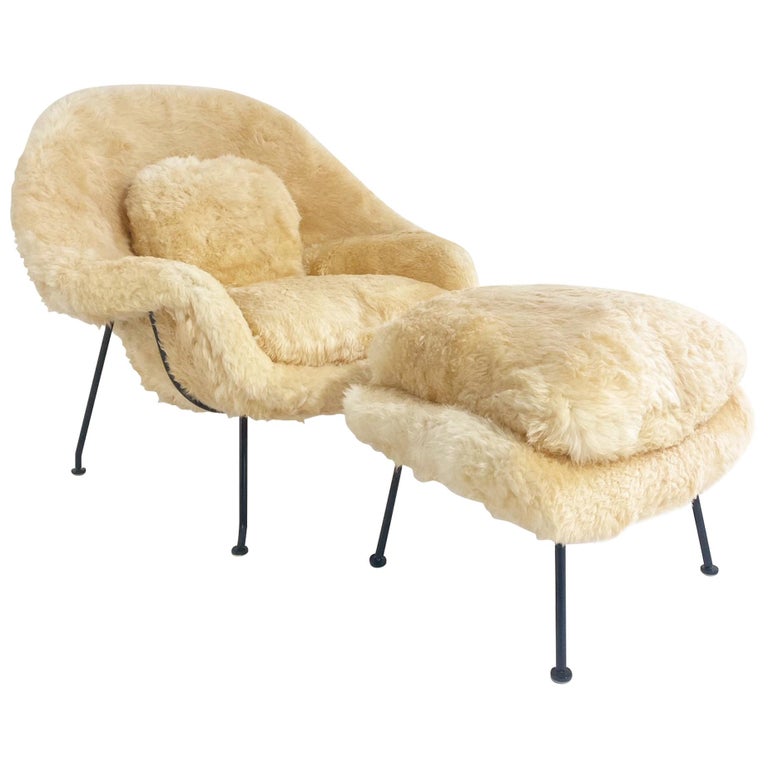
Eero Saarinen’s 1946 Womb Chair was created in response to Florence Knoll’s request for “a chair that was like a basket full of pillows.” The result is a design that cradles the sitter in an almost embryonic position of comfort and security.
The chair’s enveloping shell is made of fiberglass reinforced with foam cushioning and upholstered in a range of fabrics or leathers. The base, originally made of chrome-plated steel rods, was later updated to a more stable cast aluminum pedestal.
In a therapy setting, the Womb chair provides a deeply comforting sense of being held and protected. Its cocoon-like shape encourages clients to relax into a fetal position, evoking primal feelings of safety and nurturance. At the same time, the chair’s sculptural form and advanced construction speak to the possibilities of growth and transformation.
Panton Chair: Playful Provocation
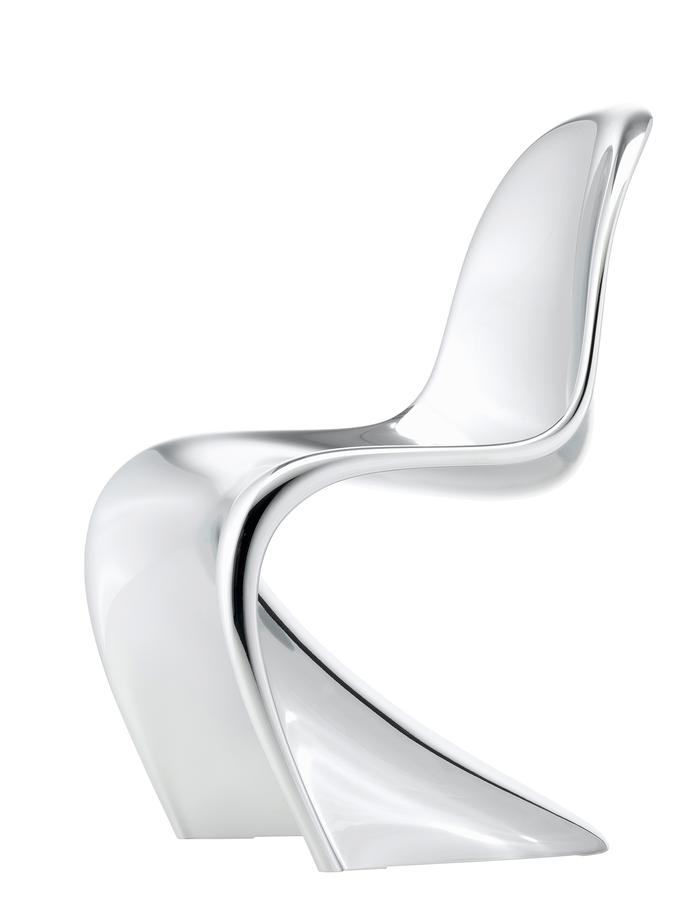
Verner Panton’s cantilevered plastic chair, designed in 1960, was a radical departure from traditional furniture forms. Molded from a single piece of dyed plastic, it creates a continuous sinuous curve that merges seat, back and base into one fluid gesture.
The Panton chair’s pop art colors and space-age silhouette project a sense of irreverence and exuberance. Its slick, seamless surface invites tactile exploration, while its springy flexibility responds dynamically to the body’s movements.
In a therapy office, the Panton chair can introduce an element of playful provocation, encouraging clients to break out of habitual postures and mindsets. Its bright hues and unconventional form signal a space of creativity and experimentation, where the unexpected is welcome. At the same time, its ergonomic design and durability ensure long-term comfort and support.
Cherner Armchair: Biomorphic Beauty
Norman Cherner’s 1958 molded plywood armchair is a study in organic minimalism. Inspired by the fluid forms of nature and the human body, its gently curving backrest and seat are shaped to provide lumbar support and distribute pressure evenly.
The chair’s bentwood construction, achieved through layers of laminated walnut or beech, gives it a sense of warmth and natural integrity. The exposed grain and visible joinery celebrate the inherent beauty of the material, while the graceful lines echo the contours of the spine.
In a therapy setting, the Cherner armchair communicates a sense of ease and flow, inviting clients to settle into a more natural, embodied state. Its biomorphic forms and rich wood tones create a calming, grounding presence, while the gently scooped seat provides a sense of security without feeling confining.
Kardiel Woodrow Box Chair: Making the Modular Unique

The Woodrow Box Chair, by American furniture brand Kardiel, puts a modern spin on the classic club chair. Its boxy, architectural frame, button-tufted upholstery, and sleek metal base create a bold, graphic silhouette that commands attention. In a therapist’s office, the Woodrow Box Chair communicates a confident, no-nonsense approach that gets straight to the heart of the matter. Offices featuring this chair often have a crisp, contemporary aesthetic with strong lines, high-contrast colors, and an air of urban sophistication. This style suits therapists who value directness, efficiency, and a solutions-focused approach to treatment.
Hans Wegner Shell Chair: At the Beach or the Office
Wegner’s Shell Chair, designed in 1963, is a masterpiece of minimalist sculpture. Its fluid, wing-like seat appears to float atop slender chrome legs, creating an ethereal sense of lightness and grace. In a therapy office, the Shell Chair communicates a sense of clarity, openness, and unencumbered possibility. Offices with this chair often have a serene, contemplative ambiance with ample open space, diffused natural light, and a limited palette of pure, understated hues. This style suits therapists who see their role as helping clients shed limiting beliefs, connect with their authentic selves, and embrace the expansiveness of their own potential. We have these in our waiting room at Taproot Therapy Collective.
Sitting with Intention
The chairs in a therapy office are more than just furniture—they are vital partners in the work of healing and growth. By curating a selection of iconic midcentury designs, therapists can create a space that embodies the highest humanistic values of the therapeutic endeavor.
The timeless forms of Wegner, the Eameses, Jacobsen and others invite presence, reflection, and open-ended exploration. Their honest materials and ergonomic contours communicate care for the body and respect for the individual. At the same time, their collective diversity mirrors the idiosyncrasy and complexity of the human experience.
When furnishing a therapy office, it’s important to choose chairs not just for their aesthetic appeal, but for their emotional and symbolic resonance. An Eames lounge chair may speak to one client’s need for creativity and optimism, while a Mogensen wingback may provide another with a sense of stability and tradition. A well-curated mix can create an environment of inclusivity and choice.
Ultimately, the power of an iconic chair lies in its ability to facilitate a state of relaxed alertness, a feeling of being both grounded and free. In the hands of a skilled therapist, the right chair can become a gateway to deeper self-awareness, authentic connection, and transformative change. By sitting with intention, we create space for our fullest humanity to unfold.
We occasionally custom mass reproduce these chairs and receive large orders of them. If you would like to order one for your space from Taproot please send me an email.
Bibliography
Crockett, E. (2018, May 28). How Arne Jacobsen Defined the Look of the Modern Hotel. Curbed. https://www.curbed.com/2018/5/28/17402022/arne-jacobsen-architect-designer-chairs-egg-swan
Dwell. (2014, April 8). Design Icon: Eero Saarinen. https://www.dwell.com/article/design-icon-eero-saarinen-be480462
Dybdahl, P. (2014). Anatomy of Danish Furniture Design: A History of Style from 1900 to the Present. Strandberg Publishing.
Eames, C., & Eames, R. (2015). An Eames Anthology: Articles, Film Scripts, Interviews, Letters, Notes, Speeches by Charles and Ray Eames. Yale University Press.
Fiell, C., & Fiell, P. (2019). 1000 Chairs. Taschen.
Harrison, R. P. (2013). Juvenescence: A Cultural History of Our Age. University of Chicago Press.
Phaidon Editors. (2016). Chairs: 1000 Masterpieces of Modern Design, 1800 to the Present Day. Phaidon Press.
Pina, L. (2003). Furniture in History, 3000 B.C.-2000 A.D. Prentice Hall.
Raizman, D. (2003). History of Modern Design: Graphics and Products Since the Industrial Revolution. Laurence King Publishing.
Williams, G. (2006). The Furniture Machine: Furniture Design Since 1990. V & A Publications.
Key Takeaways for SEO
- Iconic midcentury chair designs can lend a therapy office a sense of timeless comfort and humane values
- The Eames lounge chair embodies the couple’s optimistic faith in human potential and intuitive attunement to the zeitgeist
- Wegner’s Wishbone, Ox and Peacock chairs balance organic forms with honest materials and masterful craftsmanship
- The Bruunmunch Lobster chair offers a contemporary take on the lounge chair, with an embracing, cocoon-like form
- Jacobsen’s Egg provides a womb-like sense of enclosure with a space-age twist
- Mogensen’s 1960s Wingback communicates grounded simplicity and focus
- The Barcelona chair by Mies van der Rohe projects modernist elegance and sophistication
- Saarinen’s Womb chair cradles the sitter in an embryonic position of deep comfort
- The Panton chair introduces an element of pop art playfulness and provocation
- Cherner’s molded plywood armchair has a biomorphic beauty that invites ease and flow
- Choose therapy chairs for their emotional resonance as much as their aesthetics
- The right chair can help clients feel both relaxed and alert, grounded and free
Bibliography
Crockett, E. (2018, May 28). How Arne Jacobsen Defined the Look of the Modern Hotel. Curbed. https://www.curbed.com/2018/5/28/17402022/arne-jacobsen-architect-designer-chairs-egg-swan
Dwell. (2014, April 8). Design Icon: Eero Saarinen. https://www.dwell.com/article/design-icon-eero-saarinen-be480462
Dybdahl, P. (2014). Anatomy of Danish Furniture Design: A History of Style from 1900 to the Present. Strandberg Publishing.
Eames, C., & Eames, R. (2015). An Eames Anthology: Articles, Film Scripts, Interviews, Letters, Notes, Speeches by Charles and Ray Eames. Yale University Press.
Fiell, C., & Fiell, P. (2019). 1000 Chairs. Taschen.
Harrison, R. P. (2013). Juvenescence: A Cultural History of Our Age. University of Chicago Press.
Phaidon Editors. (2016). Chairs: 1000 Masterpieces of Modern Design, 1800 to the Present Day. Phaidon Press.
Pina, L. (2003). Furniture in History, 3000 B.C.-2000 A.D. Prentice Hall.
Raizman, D. (2003). History of Modern Design: Graphics and Products Since the Industrial Revolution. Laurence King Publishing.
Williams, G. (2006). The Furniture Machine: Furniture Design Since 1990. V & A Publications.



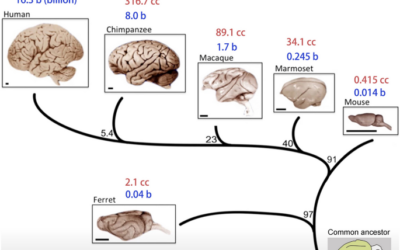

0 Comments